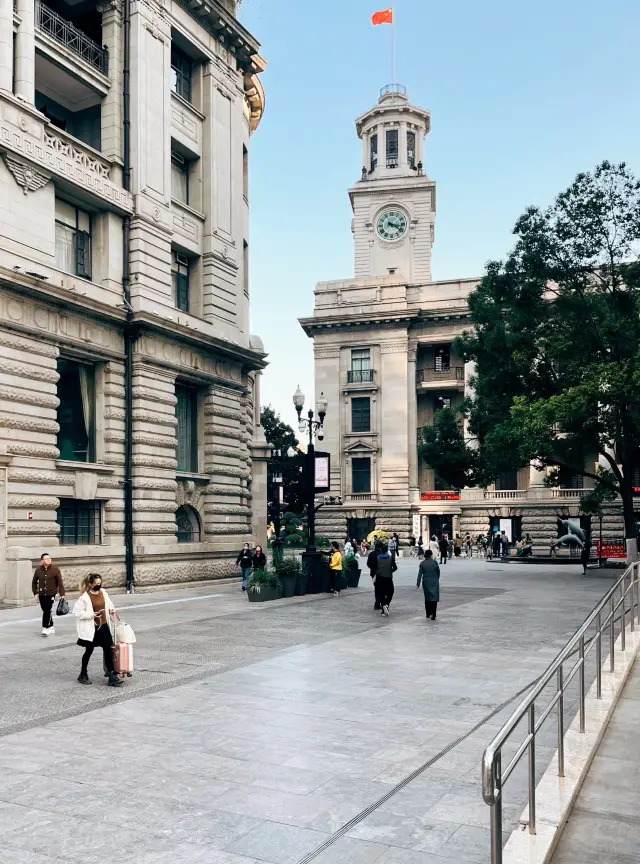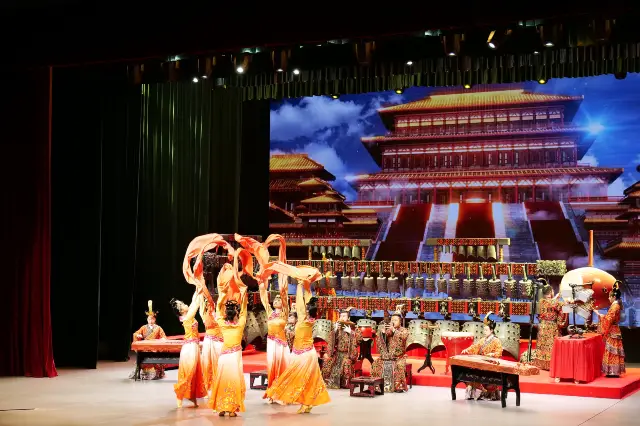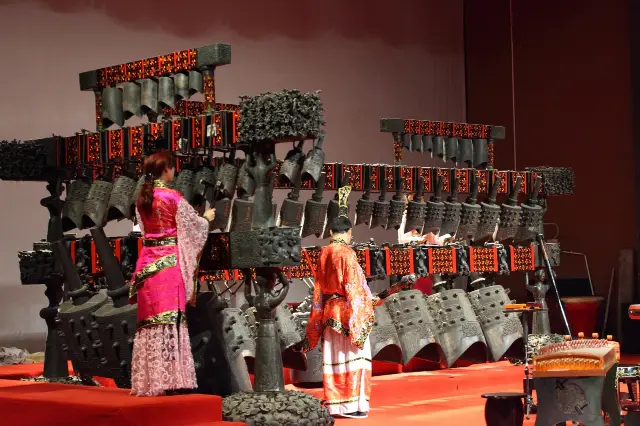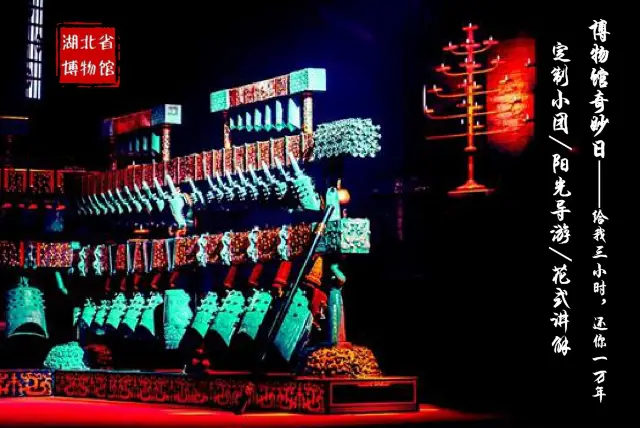2025Bianzhong Performances in Wuhan|trip.com

Introduction Bianzhong Performances in Wuhan
IntroductionThe performance of chime bells in Wuhan has a profound historical and cultural heritage. When the performance begins, the sleeping chime bells seem to be given life, emitting crisp and pleasant or deep and deep sounds, interweaving into a series of soul-stirring music. These notes jump in the air, as if leading the audience back to the ancient society where rituals and music flourished, and feeling the solemnity and splendor of the ancient emperors' sacrifices and banquets. The performance of chime bells in Wuhan has various forms, including traditional solo and ensemble forms, as well as cross-border cooperation with modern instruments such as piano, guqin, and saxophone. In addition, there are comprehensive art forms such as song and dance performances, chime bell music and dance. These diverse performance forms not only meet the aesthetic needs of different audiences, but also show the diversity and inclusiveness of chime bell music.

Yellow Crane Chimes Dance: Between curved eaves of the iconic tower, bronze chimes and Chu-style sleeves paint a landscape scroll. Musicians play 2,400-year-old pentatonic scales while dancers flutter to "Ode to the Orange" lyrics, recreating Qu Yuan's poetic era amid river breezes and clouds.

Museum Chime Dance: Before Hubei Museum's glass cases, contemporary dancers decipher bronze patterns through movement. As replica chimes play "Chu Melody," silk veils flow like seal script, awakening artifacts in lightscapes to create cross-temporal artistic dialogue.

Expo Chime Dance: In Jing-Chu Garden's mountain-water theater, landscape becomes the chimes' natural soundbox. Dancers circle bronze racks like ancient shamans, their songs blending eight Chu musical materials with nature's symphony.
Trip Moments Bianzhong Performances in Wuhan

Wuhan’s Hubu Alley 🍜
Getting There - Taking a DiDi or riding a bike are the easiest way to get there. Attractions - Very nice walking street! Enjoy a nice little stroll and buy some snacks and souvenirs. Food & Restaurants - There are plenty of little food stalls to choose from. When in Wuhan, you must try out the hot & dry noodles! 😋 Shopping - There are tons of little souvenir shops 🎁. #foodie #urbanexplorer #solotravels #china #wuhan

Must-visit pedestrian street in Wuhan| Jianghan Road Pedestrian Street
Jianghan Road can be said to be a landmark of Wuhan, perhaps it is the soul of this city, do you know? It is known as the "First Commercial Pedestrian Street in the World", and it is as famous as Wangfujing in Beijing, Nanjing Road in Shanghai, and Shangxiajiu Commercial Street in Guangzhou! If you come to Wuhan, you must go to East Lake, taste hot dry noodles, and visit the Yellow Crane Tower. However, don't forget, you must visit Jianghan Road! Jianghan Road is like a giant dragon, carrying the precipitation of history and the prosperity of commerce. When night falls, neon lights flicker, and the entire street seems to have become a dreamy fairyland. The bustling crowd and the endless flow of traffic have turned this place into a lively market. Night market vendors are fighting in the night, and the delicious food in front of the stalls emits a tempting aroma, attracting every passer-by. Vendors are promoting their own goods, and the noisy sound fills the entire street, adding a bit of hustle and bustle atmosphere. Walking into Jianghan Road is like going through a time tunnel and coming to another world. Skyscrapers rise from the ground, modern buildings and ancient streets are integrated, showing a strong urban style. The melodious music comes from the shops, and the cheerful singing lingers in the ears, soothing the tired soul. The shining neon lights dance in the night, illuminating every pedestrian's footsteps. On Jianghan Road, you can see all kinds of shops lined up on both sides of the street, and the dazzling array of goods is overwhelming. Whether you like fashion trends or pay attention to quality and style, you can find what you like here. The joy of shopping makes people intoxicated, as if every street corner is full of infinite surprises. There are not only large shopping malls with international brands, but also small shops full of personality and creativity, which make people linger. The lively street scene makes people yearn for it. Every time you pass by here, you will feel a sense of freedom and vitality. Jianghan Road is also a place where art and culture intersect. Art installations and sculptures can be seen everywhere in the streets and alleys, showing the unique charm of the city. Street artists perform here, attracting batches of audiences to stop and watch. The piano sound is melodious, the dance is light, as if this is a palace of art, every performance has become a spiritual enjoyment. Walking on Jianghan Road, you will feel a strong human touch. The hospitable people of Wuhan always greet every visitor with a smile, giving them the warmest reception. The delicious food from various snack stalls emits a tempting aroma, making people drool. The mellow aroma of hot dry noodles and the freshness of tofu skin highlight the cultural charm of this city. Jianghan Road, it is the business card of Wuhan, a charming city landscape painting. Whether it is day or night, it can bring endless surprises and happiness to people. Coming here is not only for shopping and tasting food, but also to personally feel the pulse and vitality of this city. Therefore, whether you are traveling to Wuhan or living here, an unavoidable choice is to stroll on Jianghan Road and feel the charm and enthusiasm of this city. Only by being in it can you truly understand the meaning of Jianghan Road.

Wuhan!! Average 300 per person!! It's so good to live!!
I recommend Wuhan Fengmao Anzhi Hotel to the little babies going to Wuhan. The hotel is nice! ❤Reasons for recommendation: . 🔷Praise the excellent location. Zhuye Mountain Metro Station is just outside the door🚉🚉 Hankou River Beach, Yellow Crane Tower, and Jianghan Road are all within about three kilometers🥳 And it's in the Wanda business district, so you won't step on a mine when you order takeout. There are also many supermarkets, pharmacies, and restaurants nearby✨ . 🔷The room is clean and tidy, the space is large. The bed is high and not too soft, the most important thing is that the air conditioner does not blow directly on the bed. The floor-to-ceiling window in front of the window can overlook the night view of Wuhan🌃 The TV can also be cast, so you can chase dramas while lying down. The built-in speakers in the room, the songs that come with it are very nice and sleep-inducing. The room also comes with a small living room, which is very nice👍 . 🔷The service is good. The taste of breakfast is okay, and it will be replenished at any time. The front desk lady is also very enthusiastic to help upgrade the room type. When checking out, she also gave mineral water, which is very considerate 🌟Highlights: . 1⃣The location really wins my heart. You can reach the subway entrance in a 10-minute walk!! 5 stops directly to Road. 5 stops to Hualin, 4 stops to Wuchang Railway Station, 4 stops to Simenkou Hubuxiang, it's super convenient to travel by subway! And it's close to the Yangtze River Bridge, Guishan TV Tower, and Yellow Crane Tower. There are also many delicious snacks around, and you won't step on a mine when you order takeout😆 . ✅It's really worth it to live in a room with this configuration. The projector is directly opposite the sofa, so you can nest on the sofa with your boyfriend to chase dramas. The large panoramic floor-to-ceiling window, the room has good lighting and a good view. At night, you can overlook the night view of Wuhan City🌃It's really beautiful!! . ✅The room is fully equipped with a projector, refrigerator, washing machine, and a bathroom with separate wet and dry areas. The milk tea color design and warm light make the room very warm. The landlord sister is very considerate and responds to messages in time. The security and privacy are very nice💕.

Wuhan Check-in | Optics Valley Pedestrian Street
Transportation 🚇: Exit from Exit A of Luoxiong Road Station on Metro Line 2‼️ You can start your visit from Dayoo Department Store🪩 ✅ Optics Valley Pedestrian Street—Spanish Style Street—Italian Style Street—German Style Street—French Style Street 📷 The most photogenic spot is the Duomo Cathedral 🕍 It is located at the starting point of Italian Style Street, and you can check in from the second floor of Spanish Style Street There are many check-in spots along the way, and the exotic styles of various countries are perfect for taking photos and shopping 🍲 Snacks are mainly concentrated on the second floor of the pedestrian street (Student Street), the third floor (Macau Snack Street), and the fourth floor (Mars Food Street). You can check out the recommendations and group buying deals 😃 ⚠️ If a stranger asks for help or asks you to scan a code, be sure to refuse 🙅 Don't believe them, as there are many scammers in crowded places‼️ 🏨 You can stay near the pedestrian street or the subway, which is also convenient for travel. We stayed one night at Wuhan Feiyue International Hotel (Optics Valley Pedestrian Street Optics Valley Square Metro Station), and the location and environment were good👌 I hope you have a great time and take beautiful photos 🖼

Wuhan East Lake Her Camping Farm! A great place for photos.
Attraction name: Wuhan Her Camping Farm Address: Next to Wuhan Botanical Garden Opening hours: Daily 09:00 - 17:00 Transportation guide: Self-driving: Navigate to "Wuhan Her Camping Farm", parking is convenient. Attraction features: Natural scenery: The scenery here is very suitable for taking photos and checking in. Whether it is a family photo or a personal photo, you can take beautiful photos. Parent-child paradise: There are various lively and cute small animals in the farm. Children can get close and feed them, which not only increases knowledge but also adds fun. Food experience: The catering service in the farm is surprising. The coffee is strong and delicious, and the desserts are exquisite and delicious. Even picky eaters will be satisfied. Play suggestions: It is recommended to plan your itinerary in advance, especially on weekends and holidays, when there are more tourists. Bring a camera or mobile phone to record the good times with your family. If you bring a child with you, please pay attention to safety, especially when interacting with small animals. User reviews: Comprehensive score: 4.8/5.0 Recommended reason: "The scenery here is picturesque and very suitable for taking pictures. Every place is full of natural atmosphere." "The children really like the small animals here, and the interaction session makes them very happy." "I didn't expect the coffee and desserts here to be so great, it was a surprise!" Summary: Wuhan Her Camping Farm is a great place to enjoy natural beauty, parent-child interaction and food. Whether it is adults who want to relax, or curious children, they can find their own happiness here. Next time you come to Wuhan, you might as well include it in the must-visit list!

"Great location, very close to Zhongnan Road subway station" Affordable price!!
Suixing Hotel (Wuhan Zhongnan Road Wushang Dream Times) is popular with guests. Most guests praise the hotel's great location, close to the subway station, and convenient transportation. The rooms are clean and tidy, well-equipped, and the beds are comfortable, providing a home-like feeling. The front desk service is especially praised, with enthusiastic and attentive staff, especially front desk staff like Lili and Xiaoli, who provide meticulous service and leave a deep impression. Some guests mention the hotel's rich breakfast, well-equipped gym and laundry room, and high cost performance. Overall, the hotel has an elegant environment and attentive service, making it an ideal choice for business trips and leisure travel. The hotel service is very good and enthusiastic, front desk staff Jinling has a particularly good service attitude, the hygiene is very clean, close to the scenic area, very convenient to get in and out, overall very comfortable. Clean, spacious, and bright, convenient facilities, excellent service, enthusiastic, efficient, basically responsive, mainly affordable room rates, very satisfied with the stay!

Travel Sharing | Experience Wuhan Tianhe Airport · China Eastern Airlines V3 Lounge
| Experience Wuhan Tianhe Airport · China Eastern Airlines V3 Lounge. 🔶🔶🔶 With a China Eastern Airlines business class ticket, it takes 10 minutes from check-in, security check, to the lounge. At the check-in counter, you will receive a map card for the V3 lounge, just follow it. 📍Location: After T3 security check, go down the escalator on the left, walk straight for about 100 meters and turn right, you will see V4 and V3. 🖼️Environment: • It is long and narrow, with relatively new overall decoration. There are multiple rest areas, some with sofas and office areas. 🛎️Catering: 🍜 The variety is quite rich, in addition to China Eastern Airlines' signature noodles, there are also Wuhan's specialty hot dry noodles, Xiangyang beef noodles/powder, steamed dumplings, meat buns, brown sugar sponge cake, etc. 🥘 There are hot dishes during meal times. I went outside of meal times, and besides hot dishes, everything else was available. Breakfast is served from 5:45 to 9:00; Lunch is served from 11:00 to 14:00; Dinner is served from 17:00 to 20:00. 🧁 The dining area has a buffet island, with daily pastries and sandwiches individually wrapped in plastic wrap, suitable for packing to catch a flight. There are also fresh fruits and small cups of Haagen-Dazs ice cream. 🥤 Drinks include Nestle coffee milk tea, freshly ground coffee, black tea, green tea, brown sugar ginger tea, chrysanthemum tea, etc. 🛋️Rest Area: There are several partitions, each seat has a power outlet, the sofa material is relatively comfortable, but the privacy is not enough. I heard from other friends that there is a place to take a shower, but I did not test it. 💓 Overall, this lounge of China Eastern Airlines is quite good. It's just right to have a meal and take a short rest before catching a flight.

Treasure Camping Site·Jiufeng Reservoir
A niche and free camping site by the water, just a half-hour drive away. Still wondering where to go this weekend? Worried about traffic jams on long trips! 🌿You must visit this treasure camping site near Wuhan! ✅Drive straight to the riverside ✅Huge flat lawns along the river ✅Camping, fishing, and walking the kids - all in one 📍Navigation: Jiufeng Reservoir Nearby, there are no subways or buses, so it is recommended to drive yourself. It's very convenient, less than half an hour's drive from the city, and you can also park on the roadside. 💡Travel tips: 1. It's really a super niche place, not many people around, perfect for a quiet weekend outing, great for camping. 2. You can also fish by the lake, but there are no shops nearby, so you need to bring your own equipment! 3. There's a large patch of orange flowers that are super beautiful and great for taking photos! The yellow flowers are almost over, but the white and pink oleanders by the roadside are in full bloom. There are also many red plums to pick, a bit sour. 4. There is also a Lanting Park and Jiufeng Mountain Forest Park nearby, which are super suitable for hiking and strolling.

《Charming Hotel: A Garden Courtyard Interwoven with Diverse Architectural Styles》
《Charming Hotel: A Garden Courtyard Interwoven with Diverse Architectural Styles》 🎈Hotel Features: - A blend of various architectural styles, showcasing a unique charm. Classic and modern elements intertwine, like a dialogue across time and space. - Featuring a beautiful garden courtyard, providing guests with a tranquil and elegant place to rest. 🌳Courtyard Beauty: - Stepping into the small courtyard is like entering a dream world. The perfect collision of ancient charm and modern flair, every scene exudes unique charm. - Classic architectural elements tell stories of the past, while modern designs inject new vitality. Whether in the sunlit afternoon or under the starry night, it offers a different kind of beautiful experience. 💖Recommended Reasons: - Comfortable living, meets the aesthetic of young people, simple and cozy. - Excellent location, very close to Yellow Crane Tower and Yangtze River Bridge, within walking distance, allowing you to experience the unique charm of historical sites and natural landscapes. - Recommended to friends, a fashionable and convenient place to stay. This hotel, with its diverse architectural styles and charming small courtyard, becomes a beautiful scenery on your journey. Whether you are seeking a comfortable experience or appreciating beautiful scenery, this place can meet your needs.💕

Magical area- Yellow Crane Tower 🗼🗼🗼
This historical tower is hot spot for tourists in Wuhan. The current building was built in 1980-85 years but original layout has knows ancient drawings. The Tower has 5 floors which you really need to climb around the building but you absolutely will not feel tired. With each floor you will discover more and more breathtaking view to the city. I really like the mystical- magical story behind this area which you can find out on the spot 😛😛😛 #wuhan #yellowcranetower #wuhantravel

Amazing Wuhan Yangtze River ♥️🇨🇳
#cherryblossom2024 🌸 🌅 Compared to the bustling and fireworks under the Yingwuzhou Yangtze River Bridge, the sunset and breeze of Wuhan and Wuchang Yangtze River Beach feel more peaceful. 😌🌅 💨 The gentle breeze brushing over the sunset makes it a great place for hair to stay. Come to Wuchang to watch the sunset! 🌅 ‼️ Wuhan Yangtze River Beach No. 4 Gate is located near Jiyuqiao Subway Station Exit B. Just go straight for about 500 meters. ‼️

Gude Temple, Wuhan / A Buddhist paradise hidden in the bustling city.
Gude Temple is located at No. 74, Huangpu Road, Hankou, Wuhan, Hubei. The temple was founded by Longxi in the third year of the Guangxu period of the Qing Dynasty (1877) and was initially named Gude Maopeng. It was expanded twice from 1914 to 1919 by Changhong, the presiding monk, and was renamed Gude Temple, which means "having a good heart and a love for the ancient, and universally saving sentient beings with virtue". The name of the temple was personally written by Li Yuanhong. The temple covers an area of nearly 30,000 square meters and has a building area of nearly 8,000 square meters. The temple combines the characteristics of Eurasian religious architecture and integrates the three major Buddhist sects of Mahayana, Theravada, and Tibetan Buddhism. It is rare among Chinese Buddhist temples and can be described as a "great wonder of Buddhist holy places" and the "first wonder of Chinese Buddhist temples". It has high architectural, cultural, and historical research value. It is known as one of the four major Buddhist temples in Wuhan, along with Guiyuan Temple, Baotong Temple, and Lianxi Temple. 📍Address: No. 29, Gongnongbing Road, Jiang'an District, Wuhan, Hubei, China 🎫Tickets: Free admission, but online reservation is required in advance. 🕒Opening hours: Summer: 08:00-16:30 Winter: 08:30-16:00 Last admission at 16:00 🚇How to get there: Take Metro Line 1 to Toudaojie Station (Exit C) or Metro Line 3 to Luojiazhuang Station (Exit B), and walk a short distance to get there. 📷Photo spots: Chairs in the square, Very Gude Road sign, second floor of the building next door 🤳Best time for photos: It is recommended to go after 15:00 in the afternoon. Wuhan is really too hot. If you go too early, the sun will shine in your eyes and you won't be able to open your eyes. The sky is really beautiful after 16:00, and there will be fewer people, so it's easier to queue for photo spots. 🔔Tips: ✅The temple is not big, and there are three main buildings. It takes about 1 hour to visit. ✅There are many people, and it is basically difficult to find a free place. It is recommended to arrive early or before closing. ✅The photos are very beautiful, but there are many people, so you need to use your brain to find a good photo spot.


